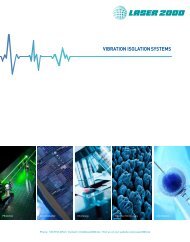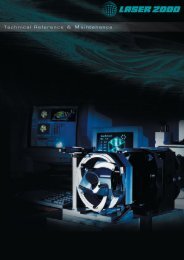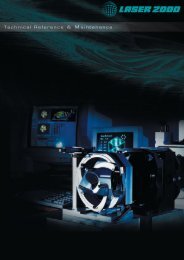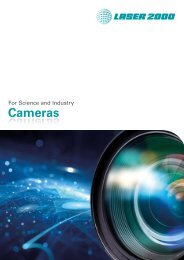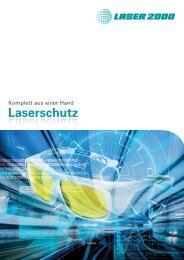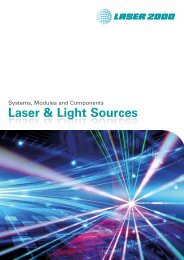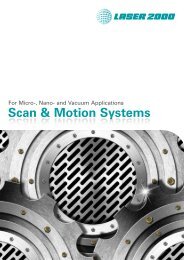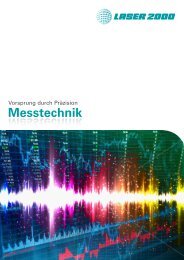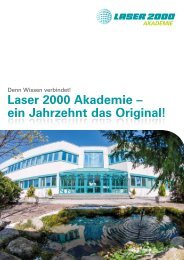Semrock Master Catalog 2018
Semrock Master Catalog 2018
Semrock Master Catalog 2018
You also want an ePaper? Increase the reach of your titles
YUMPU automatically turns print PDFs into web optimized ePapers that Google loves.
Fluorophores<br />
Single-band<br />
Sets<br />
BrightLine ® –ZERO TM Image Registration<br />
BrightLine –ZERO Fluorescence Filter Sets<br />
Only $99 ensures exact image registration when making multi-color composite images with BrightLine ®<br />
single-band sets. Not sure you<br />
need this? Keep in mind that BrightLine filters do not burn out, and the –ZERO option requires no calibration or special alignment,<br />
so why not cost-effectively future-proof your system? Join your many colleagues and demand the “–ZERO option” for certified image<br />
registration. To order, just add “–ZERO” to the end of the filter set part number.<br />
Allows you to create spatially registered multi-color composite images<br />
Hard coated for durability and reliability<br />
Ideal for demanding applications like:<br />
Co-localization fluorescence measurements<br />
Fluorescence In Situ Hybridization (FISH)<br />
Comparative Genomic Hybridization (CGH)<br />
Multiband<br />
Sets<br />
Property Value Comment Price<br />
Set-to-set Image Shift < ± 1 pixel Worst case image shift when interchanging BrightLine –ZERO filter sets, as measured<br />
relative to the mean image position for a large sample of filter sets. Analysis assumes<br />
collimated light in a standard microscope with a 200 mm focal length tube lens and<br />
6.7 micron pixel size. Tested in popular microscope cubes.<br />
+ $99 to the<br />
set price<br />
Cubes Laser<br />
Sets<br />
Available as a –ZERO Set<br />
BrightLine Single-band and Longpass Sets<br />
BrightLine LED Single-band Sets<br />
BrightLine LED Full Multiband & Pinkel Sets<br />
BrightLine FISH Sets<br />
FRET Sets<br />
Qdot Sets<br />
NOT Available as a –ZERO Set<br />
BrightLine Basic Sets<br />
BrightLine Laser Fluorescence Sets<br />
Brightline LED Sedat Multiband Sets<br />
BrightLine Multiband Sets<br />
Qdot Longpass Set<br />
Customer Selected Custom Sets<br />
TECHNICAL NOTE<br />
NLO<br />
Filters<br />
Individual<br />
Filters<br />
Dichroic<br />
Beamsplitters<br />
Tunable<br />
Filters<br />
What is Pixel Shift?<br />
Pixel shift results when a filter in an imaging path (the emitter and/or dichroic<br />
beamsplitter in a fluorescence microscope) with a non-zero wedge angle<br />
deviates the light rays to cause a shift of the image detected on a high-resolution<br />
CCD camera. When two or more images of the same object acquired using<br />
different filter sets are overlaid (in order to simultaneously view fluorescence<br />
from multiple fluorophores), any significant non-zero filter wedge angle means<br />
that the images will not be registered to identical pixels on the CCD camera. Composite images produced from conventional filter<br />
Hence, images produced by different fluorophores will not be accurately<br />
sets (above left), which typically have significant pixel shift,<br />
correlated or combined.<br />
are distorted, whereas BrightLine ZERO pixel shift filter sets<br />
(above right) yield precise multi-color images.<br />
Poor image registration, or pixel shift, results from the almost inevitable<br />
non-zero filter wedge angle. But low pixel shift is critical to obtain the best<br />
BrightLine ZERO<br />
imaging performance when exchanging filters during any measurements that involve<br />
BrightLine Hard Coating ZERO<br />
multiple exposures.<br />
<strong>Semrock</strong>’s advanced ion-beam-sputtering coating technology makes it possible for all<br />
BrightLine filters to be uniquely constructed from a single piece of glass, with the permanent<br />
hard coatings applied directly to the outside. This patented lower-loss and high-reliability<br />
construction inherently offers superior imaging performance. BrightLine –ZERO filter substrates<br />
are further manufactured and tested to the most exacting tolerances for certified “zero pixel<br />
shift” performance.<br />
With older soft-coated fluorescence filters, one is forced to use multiple substrates that are<br />
typically bonded together with adhesive, generally resulting in significant wedge angle and<br />
therefore pixel shift. To improve the imaging registration, extra processing steps, alignment<br />
steps, and/or compensating optics are required, resulting in added cost. By contrast,<br />
BrightLine –ZERO filters are inherently manufacturable and thus very affordable.<br />
Hard Coating<br />
Glass<br />
Hard Glass Coating<br />
Hard Coating<br />
Conventional Approach<br />
Conventional<br />
Uncoated<br />
Approach<br />
Uncoated<br />
Adhesive<br />
Adhesive Soft coating<br />
Soft Adhesive coating<br />
Adhesive Soft coating<br />
Soft coating<br />
Uncoated<br />
Uncoated<br />
More<br />
36



